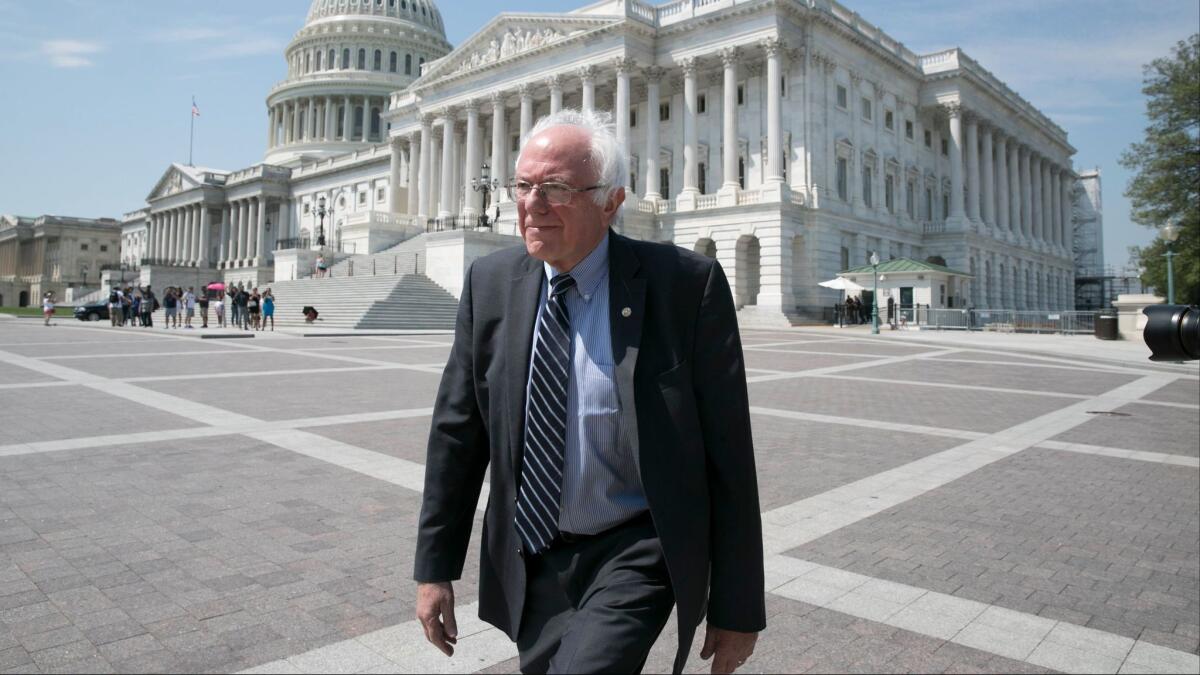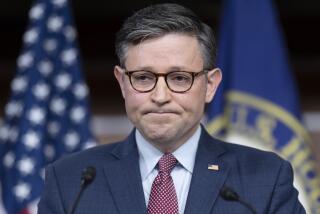Column: Here’s how expanding Medicare could set us on the path to universal health coverage

- Share via
With Republicans seeming to have abandoned their repeal-or-bust attack on the Affordable Care Act, the path to improving Americans’ health coverage is wide open.
That has given the idea of single-payer a jump-start. But it hasn’t done much to clarify the most important question: How do we get there from here?
Several routes go through Medicare, an enormously popular program that currently covers Americans 65 and older, many dialysis patients, and the disabled. Indeed, “Medicare for All” is a common mantra among single-payer advocates. But expanding Medicare to take up the slack in our health coverage system will create almost as many problems as it solves. And those will have to be addressed. Let’s see how.
In most countries, they basically say, ‘You’re covered.’...They don’t make your coverage contingent on your ability to hunt down the money to pay for it.
— Jacob Hacker, Yale University
“The political ground has shifted in two ways,” observes political scientist Jacob Hacker of Yale, who outlined a universal healthcare proposal as long ago as 2002. “During the course of the debate, there was pressure on Democrats to outline a vision of where they wanted to go.” The result was “a non-trivial boomlet for Medicare-for-all.” That concept is at the heart of healthcare plans from Rep. John Conyers (D-Mich.) and Sen. Bernie Sanders (I-Vt.).
But by leaving the ACA in place, the end of the GOP repeal campaign encouraged Democrats to build on the existing law for the next phase of health coverage expansion. “If the ACA had been completely wiped out,” Hacker says, “there would have been more pressure on Democrats to go for single-payer completely.” Medicare-for-all and the expansion of the ACA, he says, aren’t entirely compatible with one another.
Before going further, a couple of general points: “Single-payer” and “universal coverage” are often used interchangeably, but that wrong. It’s possible to have the latter without the former — indeed, every major country with universal coverage has multiple payers to some extent, though payments to doctors and hospitals for services typically are much more centrally regulated than in the U.S.
Almost every industrialized country finances its health coverage through a combination of public, private (typically employer-paid), and out-of-pocket spending. The key difference among them is the share of each category. As the accompanying chart from the Nation shows, the United States funds far more than any other country privately — at 40% of all healthcare spending, that’s nearly three times the share of the runners-up, Ireland (15%), Canada (15%) and France (14%).
The public share of healthcare spending in the U.S., meanwhile, is well below that of other industrialized countries — 49% — even though Medicaid and Medicare are two of our biggest government programs. No other country contributes less than 64% of health spending from public funds. That’s Switzerland. Countries known for their universal health coverage, such as Britain, France, Japan and the Scandinavian countries, all contribute at least 80% of healthcare costs from the public till.
“In most countries, they basically say, ‘You’re covered,’ and then they figure out how to get money from you or your employer or anybody else to finance your care,” Hacker says. “But they don’t make your coverage contingent on your ability to hunt down the money and pay for it in advance.”
That brings us back to Medicare, which resembles a single-payer program in that reimbursements to doctors and hospitals, along with mandated benefits, are centrally regulated. Part A, which covers hospitalization, is premium-free for most Americans who have paid payroll taxes during their working years. But Part B, which covers physicians, requires a monthly premium based on income, as does prescription coverage under Part D.
A and B charge enrollees deductibles and co-pays, as do some Part D plans. And Parts A and B don’t have caps on out-of-pocket spending. That’s why about one-third of enrollees choose Medicare Advantage plans, which cap out-of-pocket expenses and offer enhanced benefits, and others buy “Medigap” plans, which are offered by private insurers to fill in Medicare’s blanks. Both are offered by private insurers.
The U.S. is roughly in the middle of the pack when it comes to out-of-pocket spending as a share of the total. But it’s proper to keep in mind that U.S. healthcare costs are grossly out of line compared with other countries — at more than $9,000 per capita, its roughly twice the average among members of the Organization for Economic Cooperation and Development, OECD. That means that American pocketbooks are disproportionately affected by out-of-pocket spending, even at average ratios.
So the goal really is universal coverage. Single-payer, in which the government pays all healthcare costs for everyone, is one way to get there, but not the only way. As we wrote in May, when a single-payer plan was before the California Legislature (it failed), “single-payer almost certainly would be cheaper and simpler than the ridiculous contraption we have now, a mishmash of employer, government and private plans all with different rules and standards” and is “favored by a clear majority of Americans in opinion polls, at least in theory.” But covering everyone is Job One, and figuring out how to pay for it is Job Two.
So traditional Medicare isn’t as good as the typical large-employer plan or even ACA plans, which cap out-of-pocket spending. For a non-elderly population, Medicare benefits would have to be expanded to cover such services as pediatric care, maternity and birth control.
That suggests that replacing existing health coverage with Medicare for all without a lengthy transition period would be a heavy political lift, as Paul Starr of Princeton observed in March, during the heat of the GOP attack on the ACA. “Medicare-for-all faces two enormous obstacles,” he wrote. “Moving everyone under age 65 into Medicare would require a huge increase in taxes; employees who now receive health care as a fringe benefit would inevitably look at those taxes as an additional burden, even if reformers try to assure them that their wages would rise once health care was financed by taxes.” The second obstacle is seniors’ fear that “extending the program to others will jeopardize their coverage.”
Overcoming these obstacles would require lengthy political debates over the breadth of coverage and how to distribute costs, especially to the extent that it would involve raising taxes on the rich — very similar to the debate about those issues during the drafting of the Affordable Care Act and in the seven years since its enactment.
Yet some intermediate steps suggest themselves. In an essay published this month in Health Affairs, Hacker, Starr, and Gerard Anderson of Johns Hopkins University suggest making Medicare available on the ACA exchanges, say in any county or region with two or fewer competing private insurers. That would turn Medicare into a sort of public option of the sort that was initially contemplated for the ACA. They also propose that private insurers offering Medicare Advantage plans in any region be “required to offer such plans within the exchanges as well” — a trade-off using the insurers’ desire for the profits they reap from Medicare Advantage, which are substantial, to goad them into improving the offerings in the individual exchanges. (We’ve recommended a similar arrangement that would require insurers bidding for desirable Medicaid expansion contracts in a state to participate in the exchanges.)
“We know that Medicare Advantage plans already operate in counties where there are no private insurers,” Hacker says. “We know how to do this.” Over time, the Medicare offerings could be expanded into counties with more competing insurers, and eventually nationwide. “A lot of questions would remain and this is not going to happen overnight be any means, but you can see how it works in discrete steps and moves us in the direction of Medicare for all.”
Hacker would couple that arrangement with a pay-or-play requirement for employers — not a mere tax on those that don’t offer coverage to their workers, as exists under the ACA’s employer mandate, but a requirement that they actually contribute to the cost of their coverage within a Medicare-like system. For small businesses this could be a modest charge, but as Hacker argued in a 2007 version of his “Health Care for America” plan, it would ensure that “no one with a direct or family tie to the workforce would remain uninsured.”
Other proposals for gradually extending Medicare include lowering the eligibility age from the current 65 in stages — say to 60 or 55 in the near term. (Starr called this “midlife Medicare.”) This has the virtue of guaranteeing coverage to a segment of the uninsured population most at risk of heavy medical expenses, since on average they have greater medical needs than younger Americans and even under the ACA can be charged higher premiums. On the downside, they’re expensive to cover, which means finding new funding for their care.
The most important political shift resulting from the failed GOP repeal effort may be the assumption that everyone should be covered. That’s implied bythe Congressional Budget Office’s determination that the GOP’s repeal plans would deprive more than 20 million Americans of their coverage — a finding that arguably delivered the death blow to the GOP’s repeal dream. That shift may finally have put the U.S. on the path to universal coverage, and all we’re really arguing about now is how to pay for it.
Keep up to date with Michael Hiltzik. Follow @hiltzikm on Twitter, see his Facebook page, or email [email protected].
Return to Michael Hiltzik’s blog.
More to Read
Get the L.A. Times Politics newsletter
Deeply reported insights into legislation, politics and policy from Sacramento, Washington and beyond. In your inbox three times per week.
You may occasionally receive promotional content from the Los Angeles Times.











